I’ve always had a bit of a fear of heights. Not really sure where it comes from, but I’ve never been a big fan of not the ground. It’s gotten better over the years, but I still wasn’t a huge fan of living on the 13th floor of an apartment building a few summers ago. And I still have dreams from time to time of being at the top of a swaying 90-story building. So like… you know, it’s still a very distant relationship.
A Solid Foundation
Despite its name, you won’t have to worry too much about heights as you play through High Rise, the latest title from Gil Hova and Formal Ferret Games. Instead, you’ll have to worry about building a real estate empire without being super corrupt. So, like, not heights at all. So no worries, acrophobics!
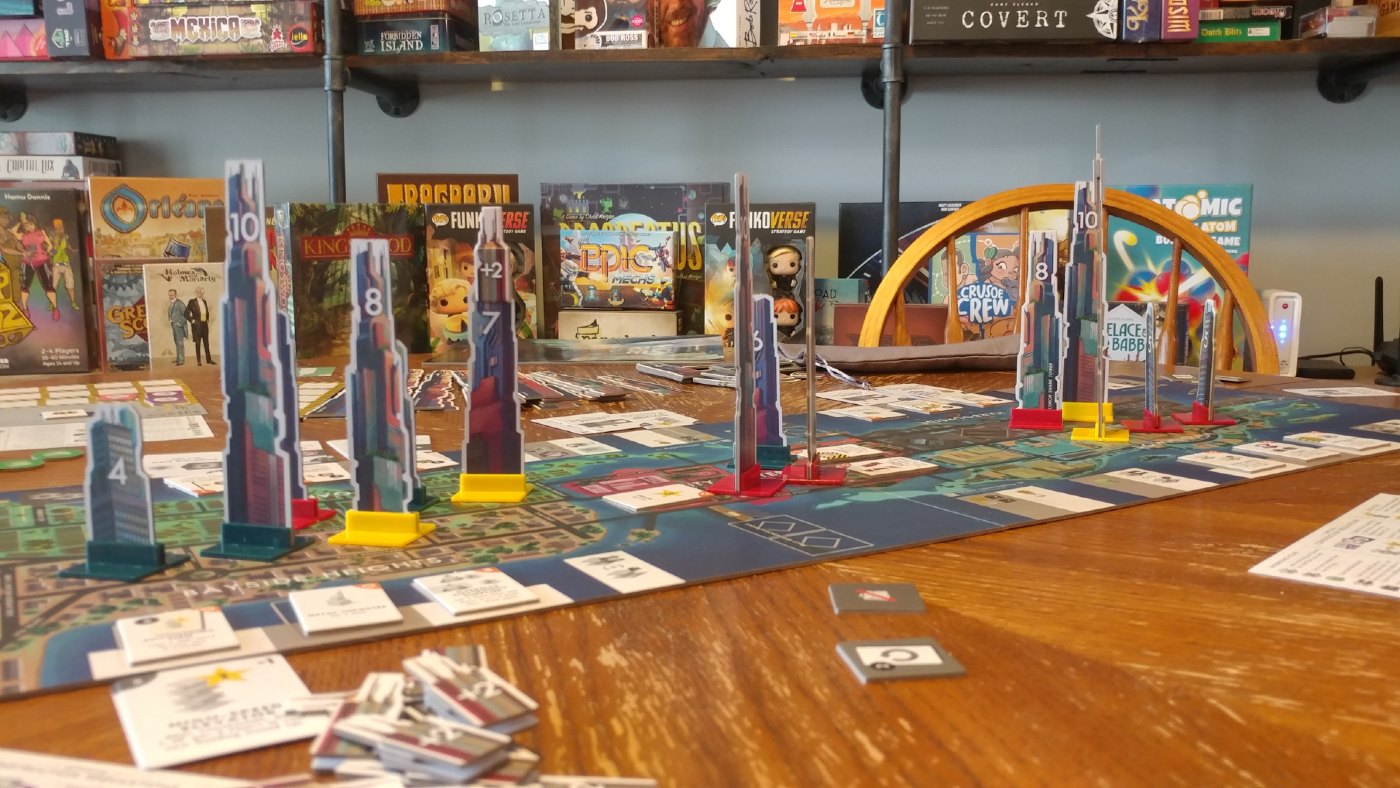
On the surface, the rules of High Rise seem very straightforward. Players will be moving around the board, trying to collect resources so that they can construct buildings so that they can gain victory points. This takes place over two or three rounds, depending on which setup you’re using. At the end of each round, points are given out for having the tallest buildings, while points are taken away if you are too corrupt. At the end of the game, the player with the most victory points wins!
Movin’ on Up
But while the core rules are simple, there are plenty of little wrinkles that make the game more complex and, in my opinion, more fun.
Movement works as it does in games like Tokaido or PARKS, where the person furthest behind on the track takes a turn, and they can move as far along the track as they want. Each location on the board provides some sort of benefit. Some give you the resources you need to build structures – different types of ‘floors’ and the mysterious ‘Ultra Plastic’. Others give you cards that you can use as a bonus on a later turn. There are also places where you can get bonus tiles if you happen to be one of the first players to pass over them.
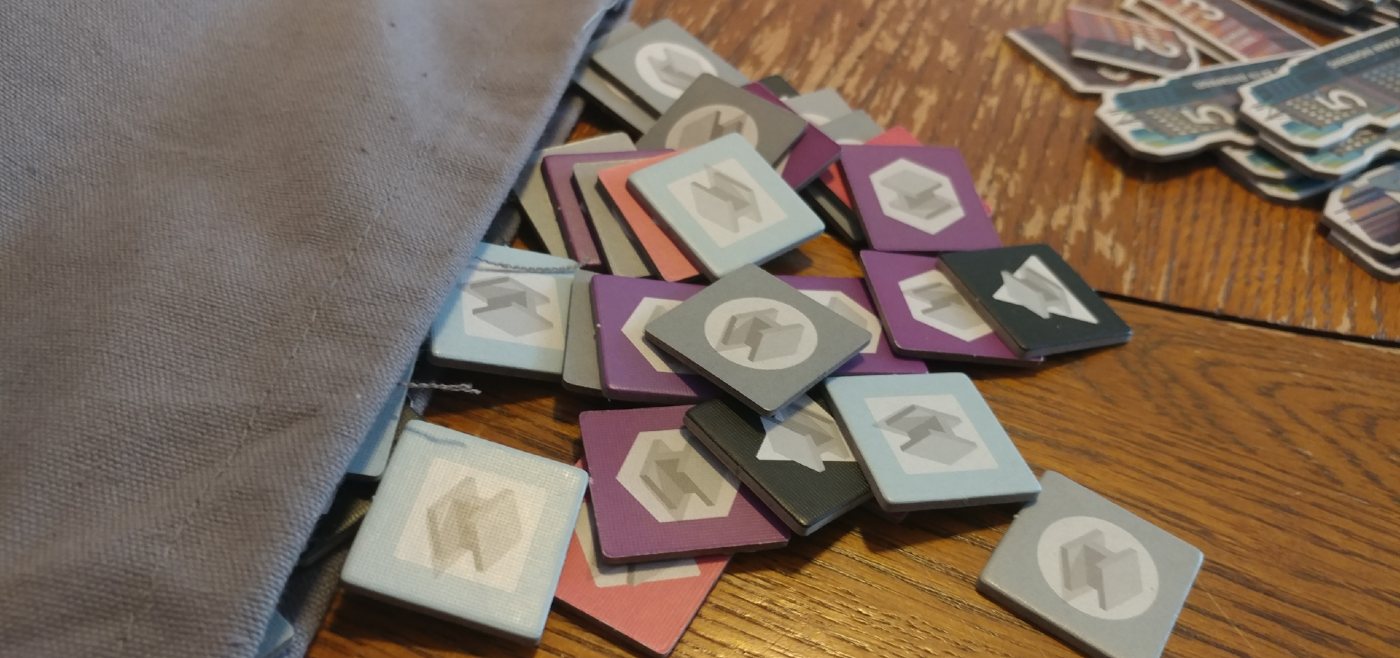
But perhaps most important of all are the build spaces. There are only four sections of the board that have build spaces, and there is not enough room for all of the players in these areas. So let the fighting begin! To make things even more interesting, usually all but one of the spaces will cause you to gain corruption when you build, so you’ll all be vying for that one ‘free’ building spot.
In most games with this movement mechanic, players generally move one or two steps beyond the person furthest ahead. However, with the way that the board is set up, High Rise seems to reward risk-taking a little more than other titles. There were occasions where some players would take tremendous leaps down the board just so that they could get the right resources or ensure that they get to build.
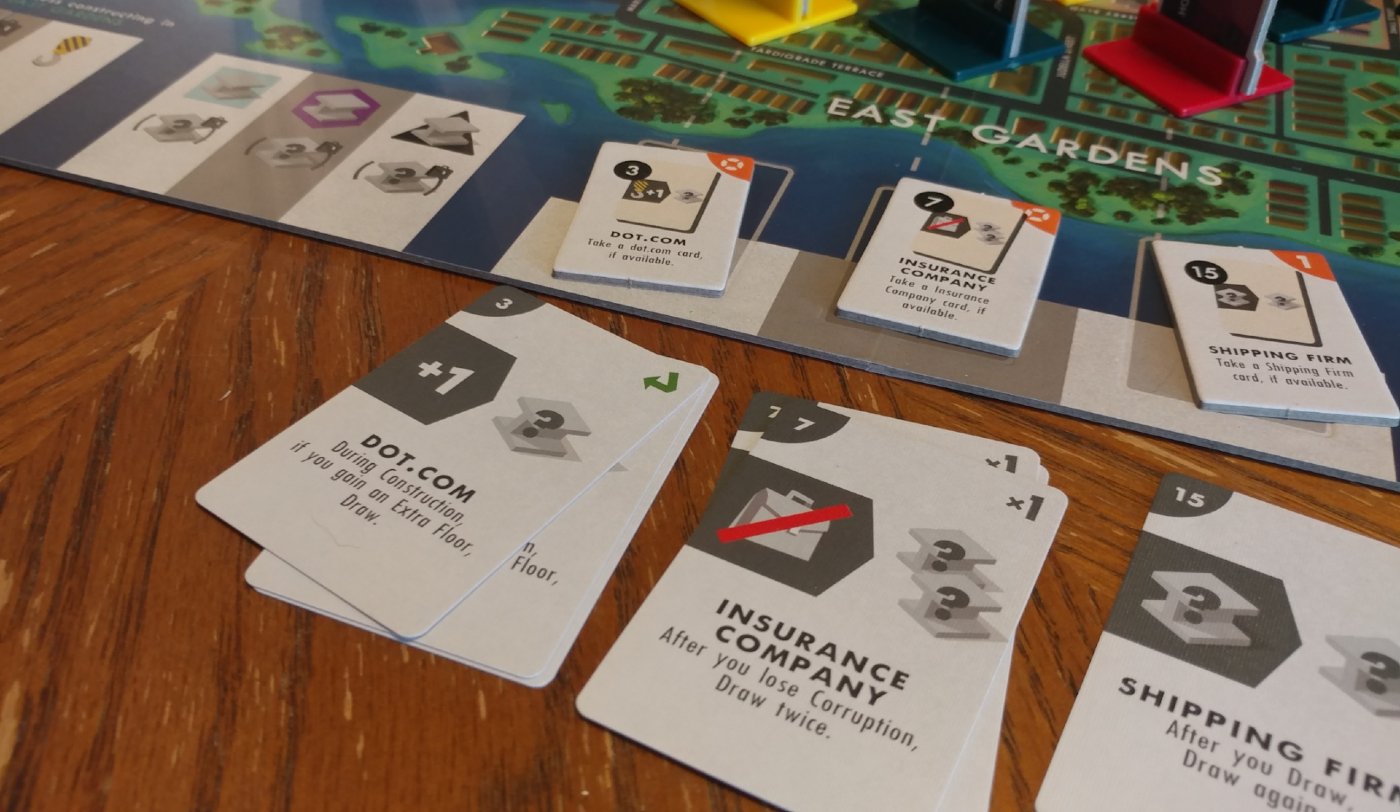
Beyond the Blueprint
The way in which buildings are constructed is also much more complex than meets the eye. At the beginning of each round, a card is dealt out that shows the different combinations of floors that players can use for construction in that round. These combinations get larger as you progress through the game, allowing you to build taller structures.
Normally, construction involves landing on a building space, paying the right amount of floors, and then getting a building that has a size equal to the number of floors you paid. However, there are little bonuses all over the place that you can use to make your building taller. You get an extra floor if you’re the first player to build with that particular blueprint. You get an extra floor if you use Ultra Plastic the right way. You can also get extra floors from cards that you have obtained from other locations on the board. You could even add a spire to your building that makes it two floors taller.
So what’s the big deal about tall buildings? Well, the tallest buildings will earn bonus points at the end of each round. In addition, there’s limited space on the board, and when a section of the board is full of buildings, you’ll need to make a building that is taller than at least the shortest building in a section to destroy that tiny building and put your own in its place.
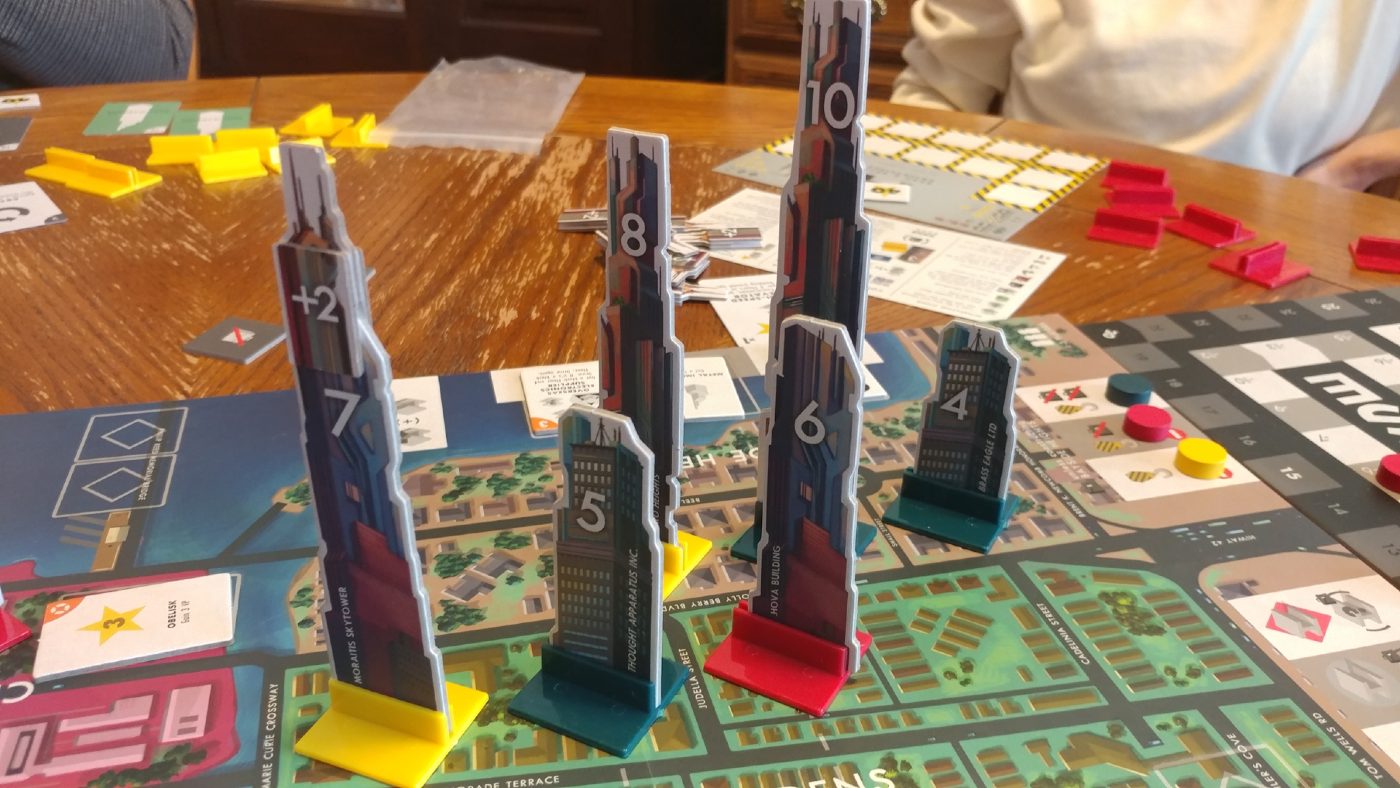
Just like with the movement, all the little wrinkles provide a complexity that add to the enjoy-ability of the game. You’ll plan several moves in a row to get the right cards and floors before you get to a building location. However, everyone else is doing the exact same thing, so you’ll have to adjust quickly if you want to stay in the game.
Reaching the Top
The one outstanding mechanic I haven’t hit on yet is corruption. Basically, you’ll have the opportunity to make your turns and choices a little more powerful from time to time by being a little bit corrupt. A little bit of corruption won’t hurt, but let it build up over each round and it can really come back to bite you in the form of lost victory points. There are a few ways to cut down on your corruption scattered throughout the board, so that adds another element to consider as you move.
With everything going on in this game, it would be no surprise if High Rise was a crazy disjointed mess. But, this is one of those games that you can tell really went through a tremendous amount of play-testing to get the balance right. It’s in those tiny little rules, like how you can only stop in each section once, or how you can build a shorter building that gets sent “out to the suburbs”. Thus, you’re left with a tight game that flows so well from turn to turn.
Touch the Sky
My complaints about the game really have little to do with the game experience at all. I can narrow it down to two things. First, the rule book is oddly set up. While I appreciate that it looks like a blueprint, I really could only understand some aspects of the game by watching an explanation video. Secondly, there are just simply not enough bags. I could easily use ten more in order to organize all the different types of tiles and other game pieces, so set up is going to be a nightmare every time I play.
But I will play it again and again. It’s one of those games that I’m excited to share with my other board gaming friends. But it’s also accessible – my main play-testers are not people that have giant collections and play every weekend. And we actually finished our playthrough in less time than the box suggested. That never happens!
So I guess that makes High Rise a versatile, accessible, enjoyable game that looks really cool on the table (I didn’t even mention the components that much!). That seems like a pretty nice build to me.
(Okay, I tried to come up with a good pun to wrap up this review for like 10 minutes, and that’s the best I could come up with. Leave me alone! I’m tired!)
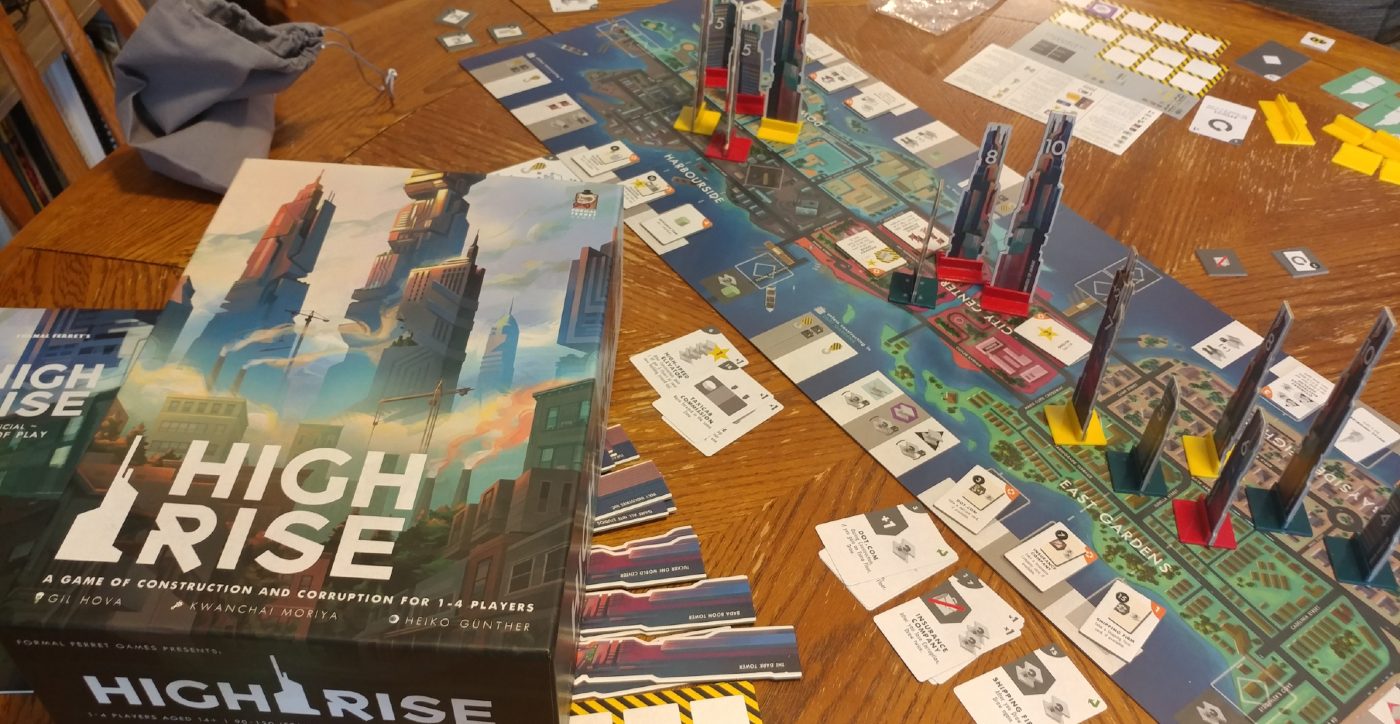
You can purchase a copy of High Rise at your local game store or online through Amazon or the Formal Ferret website today.
Formal Ferret Games provided us with a retail copy of the game for this review.
Highs
- Very solid rules that are intricately woven together
- Solid components that look really good as the game progresses
- You will be engaged the whole time, even when it’s not your turn
Lows
- The rulebook could be clearer
- Give me more little bags!



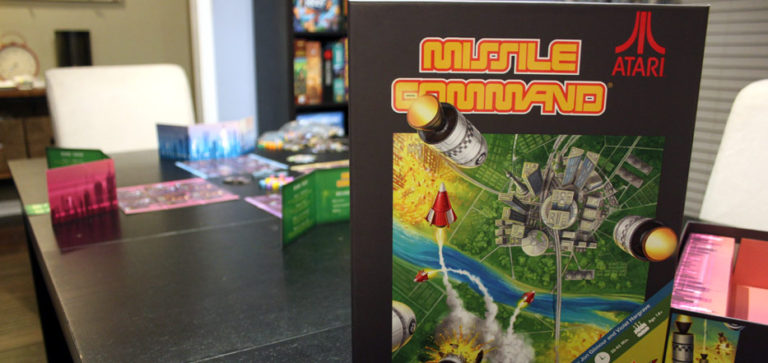

[…] High Rise Review […]